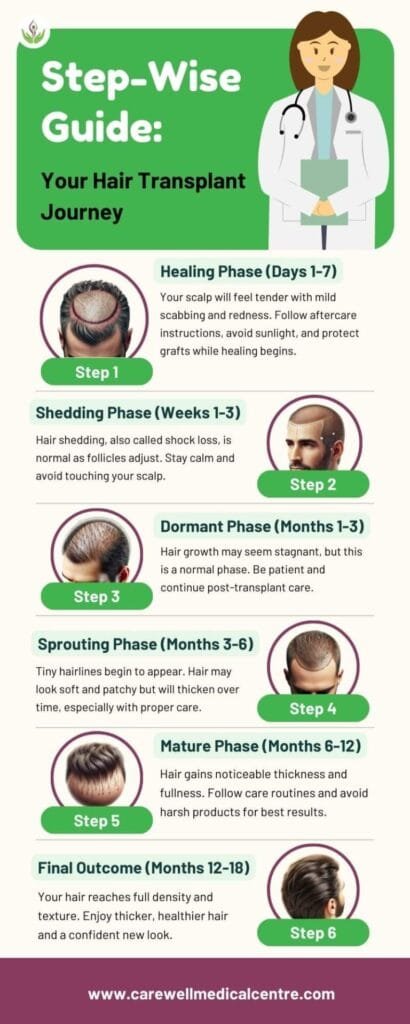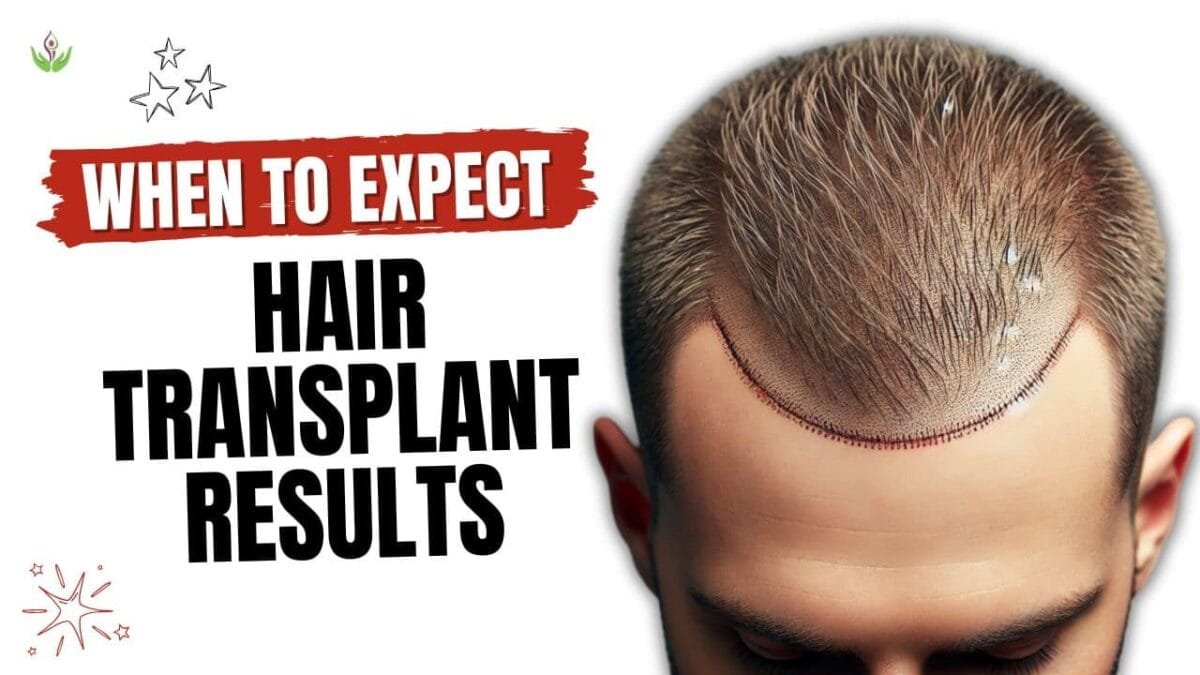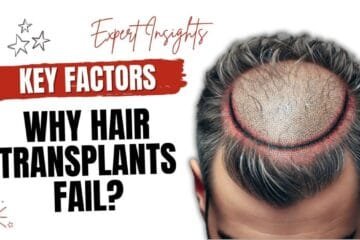Introduction
Hair plays a crucial role in defining our appearance, personality, and confidence. However, sudden hair loss can be emotionally and physically distressing. Many factors contribute to hair fall, leading individuals to consider solutions like hair transplants. Understanding the hair transplant results timeline helps set realistic expectations for regrowth and transformation.
Some of the factors can be because of your eating habits, your stress levels, your entire sleep cycle, and hormone changes after a certain age. But have you imagined that there is a permanent solution for your hair loss problems? Yes, you heard that right. The solution is hair transplantation.
You might be wondering how long it takes for hair transplant results to show up. Read this article and get to know the time span.
Step Wise Guide: Your Hair Transplant Results Timeline Journey
Step 1: Healing begins within the first few days of your hair transplantation (Days 1-7)
In the first week, after you are done with your hair transplantation, your scalp will start getting tender and look like a sore, scabbing around the grated follicles. This sign indicates your hair has started the healing process.
- In this period, you need to follow your surgeon’s instructions for the hair transplant aftercare routine.
- Be careful and gentle with your grafted area. Sleep on the other side to avoid any damage.
- You will need to avoid direct sunlight.
In the first week, you will experience certain changes. Scabbing and redness will appear, but this phase is a normal part of the healing process. Do not panic; stay calm and positive throughout the journey. During this initial stage of the hair transplant results timeline, your scalp and grafts will heal and adjust before new hair growth begins. To stay distracted and relaxed, consider reading, watching movies, or attending social gatherings.
Step 2: Hair starts falling. This is called the shredding phase (Weeks 1-3)
Between the first and third weeks, you will notice a considerable hair fall. This stage is absolutely a normal phase, and you don’t need to panic and get stressed about it. This is called the shredding process. It happens because your grafted follicles start resetting to normal hair. This shredding is also sometimes referred to as shock loss.
- Shock loss occurs because your follicles are being adjusted to a new location and environment.
- This shedding is sometimes referred to as shock loss after hair transplant.
- You need to keep calm and positive.
- Do not touch your scalp at any cost and immediately consult your surgeon for any issues.
Step 3: This is the dormant phase where you may require patience and calmness (Months 1-3)
In this phase, you experience that your hair growth is stagnant and not responding to a hair transplant. But such behavior is normal, and you need to keep it calm and have patience.
- Please know that results in this phase are minimal or not visible.
- Do not panic and take any step towards your hair.
- Keep calm and watch out for progress or any wrong indication. You may wish to consult your surgeon promptly.
Remember, if you are one of those expecting a result after 30 days or a month, you are mistaken. It takes time; keep patience.
Step 4: Your hair starts growing. This is the sprouting phase. (Months 3-6)
After approximately 3 months or 90 days, you will start experiencing small, tiny hairlines popping through your scalp. This stage is the most exciting phase, as hair growth starts showing up, and you can visibly see it. The tiny and soft hair will thicken over the weeks. Thickening of your hair can take up to 6 months to show.
- Younger patients can see faster results, especially when following tips for the best hair transplant results.
- If you have opted for the FUE method, then recovery and growth are faster.
- Your scalp becomes healthier.
You may experience:
- Patchy hair growth, which is normal.
- Your hair may look soft and delicate but will thicken and mature in the coming weeks.
- The entire process will take between 3 to 6 months to show up.
Step 5: You get thicker and fuller hair. This is the mature phase. (Months 6-12)
After 6 months, you will start seeing your hair grow fully and in a thicker way. This phase is the maturity of your hair.
- Ensure your transplanted hair lasts long by following your surgeon’s recommended care routine.
- Keep calm and follow your scalp and hair care routine given by your surgeon.
- Avoid using any harmful or chemical products on your hair. Keep it simple and growing.
Step 6: Outcome. Visible final results (Months 12-18)
You should know that the outcome will start to show between 12 to 18 months, depending on individual factors such as age and hormones. As you progress through the hair transplant results timeline, you’ll notice fuller, thicker, and healthier hair compared to before. This transformation indicates the success of your hair transplant. After this period, your hair will achieve its final texture and optimal density.
Testimonial: A real-world example case
Ravi was a patient who had a severe hair loss problem. And he sought our advice and went for a hair transplant. Today, Ravi, after 18 months, stands tall and handsome with full and thick hair. He recounts how low and sad he used to be earlier, but now he has regained his confidence.
Ravi had the patience and trusted the entire process. He saw the results and was happy now.
Ravi followed his surgeon’s instructions.
Ravi did take care of his scalp as recommended by his surgeon.

Conclusion
You should now understand that the hair transplantation process and the aftercare phase require time and patience. Following your surgeon’s recommendations and caring for your scalp throughout the hair fall and shedding stages is essential. Staying patient and committed to the journey will help you achieve the best results. Once you see the progress in your hair transplant results timeline, you will feel more confident and satisfied with your transformation.
What are you waiting for? Come get your hair transplant and become a confident personality. Call us now.
FAQs
Typically, you’ll start seeing noticeable hair growth between 3 to 6 months after the procedure. Full results, including optimal density and texture, usually appear between 12 to 18 months. This timeline allows the transplanted follicles to grow and thicken gradually.
Yes, shedding, known as “shock loss,” is a normal part of the hair transplant process. It generally occurs within the first two to three weeks after surgery, as the transplanted hair follicles adjust and prepare for new growth. The shed hair makes way for healthier, thicker hair to emerge.
Hair grows in cycles, and each follicle takes time to settle, grow, and thicken after a transplant. This gradual growth process is essential for producing natural-looking results. The follicles go through a resting phase, a sprouting phase, and a maturation phase before reaching full growth.
While there’s no way to drastically accelerate hair growth, following aftercare instructions, keeping a healthy lifestyle, and avoiding scalp irritation can help create the best environment for hair to grow optimally. Staying hydrated, eating a balanced diet, and managing stress can also contribute positively.
In some cases, a second procedure may be recommended to achieve additional density or address other areas affected by hair loss. This depends on individual goals and hair loss progression. It’s best to consult your surgeon after you see your initial results to determine if a second session would be beneficial.
A hair transplant is generally successful, but like any medical procedure, results can vary. If you haven’t observed results within the expected timeline, please consult your surgeon. They may assess factors like scalp health, post-op care, and lifestyle that could impact growth.
Yes, hair transplants offer long-lasting results since the transplanted hair follicles are usually resistant to the hormone responsible for hair loss (DHT). However, natural aging and genetic factors may affect hair density over time. Regular check-ins with your doctor can help maintain and optimize your results.
Most people can return to regular activities within a week after surgery. However, it’s recommended to avoid strenuous exercise, direct sun exposure, and any activities that might irritate the scalp for the first two to three weeks to allow proper healing.
Once the hair has grown to a suitable length, you can style it as you like. It’s advised to wait until the transplanted hair has fully settled, typically after six months, before using heat tools or chemical treatments to avoid any stress on the new follicles.
Mild itching and discomfort are common in the early stages of healing. Your surgeon might recommend a gentle moisturizer or medicated shampoo to relieve itching. Avoid scratching, as it can disturb the grafts and prolong the healing process.
With modern techniques like Follicular Unit Extraction (FUE), the results are designed to look natural and blend seamlessly with your existing hair. By the time full results are visible, the hair should look and feel like your own, minimizing any noticeable signs of surgery.
Following aftercare instructions closely, avoiding unnecessary stress on the scalp, and attending follow-up appointments are key steps to ensure a successful transplant. Additionally, keeping a healthy diet, staying hydrated, and minimizing alcohol and tobacco use can support healthy hair growth.
In 7 days you will not have any visible change but will experience scabbing and a sore scalp.
After 30 days of your hair transplant, you will start experiencing the hair fall phase known as the shredding phase.
Yes, the results are permanent, and your new follicles are resistant to hair loss.
It will take anywhere between 12 to 18 months to show fuller and healthier hair.














